Project: Guide to Leadership and Management - Analysis & Insights
VerifiedAdded on 2021/02/21
|13
|4025
|24
Project
AI Summary
This project provides a detailed guide to leadership and management, encompassing various aspects of effective leadership. It begins by identifying key traits of a good leader, such as trust, commitment, openness, conscientiousness, and extraversion, as well as the impact of these traits on leadership capabilities. The project then delves into the development of leadership, exploring whether leadership skills can be cultivated, and examining theories like the Path-Goal theory, which includes supportive, achievement-oriented, directive, and participative leadership styles. It also highlights the importance of relational and transformational leadership. Finally, the project differentiates between leadership and management, outlining their respective focuses, approaches, and orientations. The project uses figures and sources to support its arguments and concludes that leadership can be developed through commitment, passion, and situational awareness. The document is available on Desklib for students to enhance their understanding.
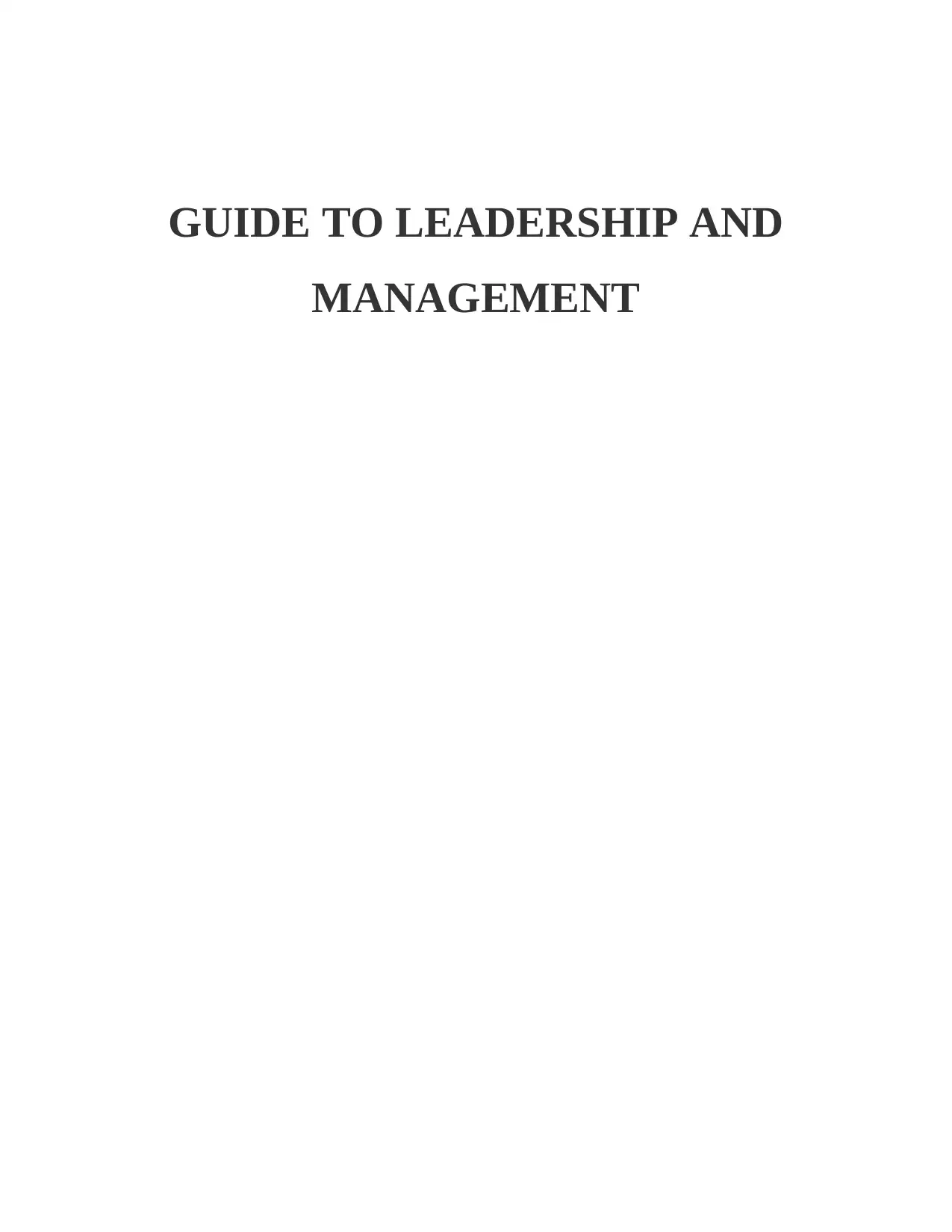
GUIDE TO LEADERSHIP AND
MANAGEMENT
MANAGEMENT
Paraphrase This Document
Need a fresh take? Get an instant paraphrase of this document with our AI Paraphraser
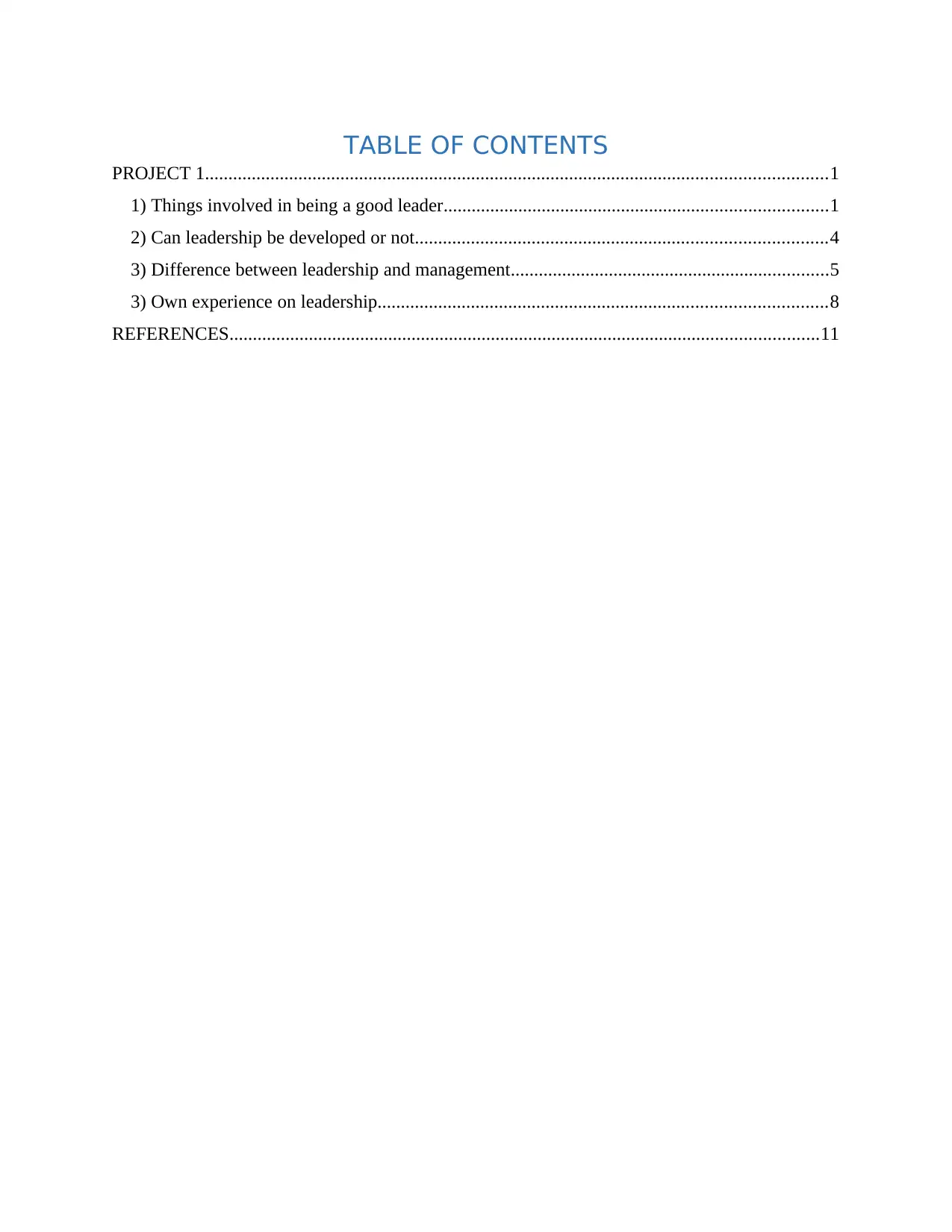
TABLE OF CONTENTS
PROJECT 1.....................................................................................................................................1
1) Things involved in being a good leader..................................................................................1
2) Can leadership be developed or not........................................................................................4
3) Difference between leadership and management....................................................................5
3) Own experience on leadership................................................................................................8
REFERENCES..............................................................................................................................11
PROJECT 1.....................................................................................................................................1
1) Things involved in being a good leader..................................................................................1
2) Can leadership be developed or not........................................................................................4
3) Difference between leadership and management....................................................................5
3) Own experience on leadership................................................................................................8
REFERENCES..............................................................................................................................11
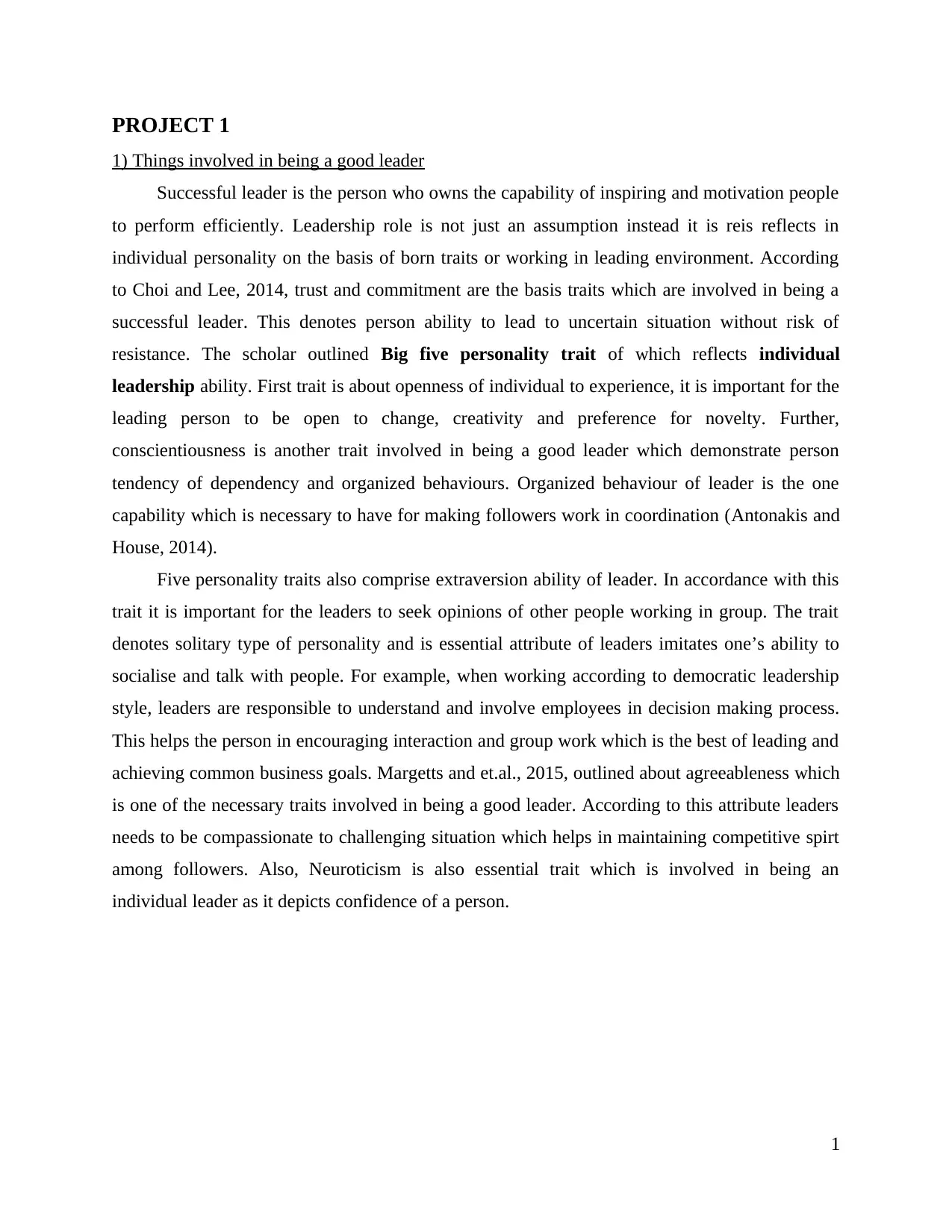
PROJECT 1
1) Things involved in being a good leader
Successful leader is the person who owns the capability of inspiring and motivation people
to perform efficiently. Leadership role is not just an assumption instead it is reis reflects in
individual personality on the basis of born traits or working in leading environment. According
to Choi and Lee, 2014, trust and commitment are the basis traits which are involved in being a
successful leader. This denotes person ability to lead to uncertain situation without risk of
resistance. The scholar outlined Big five personality trait of which reflects individual
leadership ability. First trait is about openness of individual to experience, it is important for the
leading person to be open to change, creativity and preference for novelty. Further,
conscientiousness is another trait involved in being a good leader which demonstrate person
tendency of dependency and organized behaviours. Organized behaviour of leader is the one
capability which is necessary to have for making followers work in coordination (Antonakis and
House, 2014).
Five personality traits also comprise extraversion ability of leader. In accordance with this
trait it is important for the leaders to seek opinions of other people working in group. The trait
denotes solitary type of personality and is essential attribute of leaders imitates one’s ability to
socialise and talk with people. For example, when working according to democratic leadership
style, leaders are responsible to understand and involve employees in decision making process.
This helps the person in encouraging interaction and group work which is the best of leading and
achieving common business goals. Margetts and et.al., 2015, outlined about agreeableness which
is one of the necessary traits involved in being a good leader. According to this attribute leaders
needs to be compassionate to challenging situation which helps in maintaining competitive spirt
among followers. Also, Neuroticism is also essential trait which is involved in being an
individual leader as it depicts confidence of a person.
1
1) Things involved in being a good leader
Successful leader is the person who owns the capability of inspiring and motivation people
to perform efficiently. Leadership role is not just an assumption instead it is reis reflects in
individual personality on the basis of born traits or working in leading environment. According
to Choi and Lee, 2014, trust and commitment are the basis traits which are involved in being a
successful leader. This denotes person ability to lead to uncertain situation without risk of
resistance. The scholar outlined Big five personality trait of which reflects individual
leadership ability. First trait is about openness of individual to experience, it is important for the
leading person to be open to change, creativity and preference for novelty. Further,
conscientiousness is another trait involved in being a good leader which demonstrate person
tendency of dependency and organized behaviours. Organized behaviour of leader is the one
capability which is necessary to have for making followers work in coordination (Antonakis and
House, 2014).
Five personality traits also comprise extraversion ability of leader. In accordance with this
trait it is important for the leaders to seek opinions of other people working in group. The trait
denotes solitary type of personality and is essential attribute of leaders imitates one’s ability to
socialise and talk with people. For example, when working according to democratic leadership
style, leaders are responsible to understand and involve employees in decision making process.
This helps the person in encouraging interaction and group work which is the best of leading and
achieving common business goals. Margetts and et.al., 2015, outlined about agreeableness which
is one of the necessary traits involved in being a good leader. According to this attribute leaders
needs to be compassionate to challenging situation which helps in maintaining competitive spirt
among followers. Also, Neuroticism is also essential trait which is involved in being an
individual leader as it depicts confidence of a person.
1
⊘ This is a preview!⊘
Do you want full access?
Subscribe today to unlock all pages.

Trusted by 1+ million students worldwide
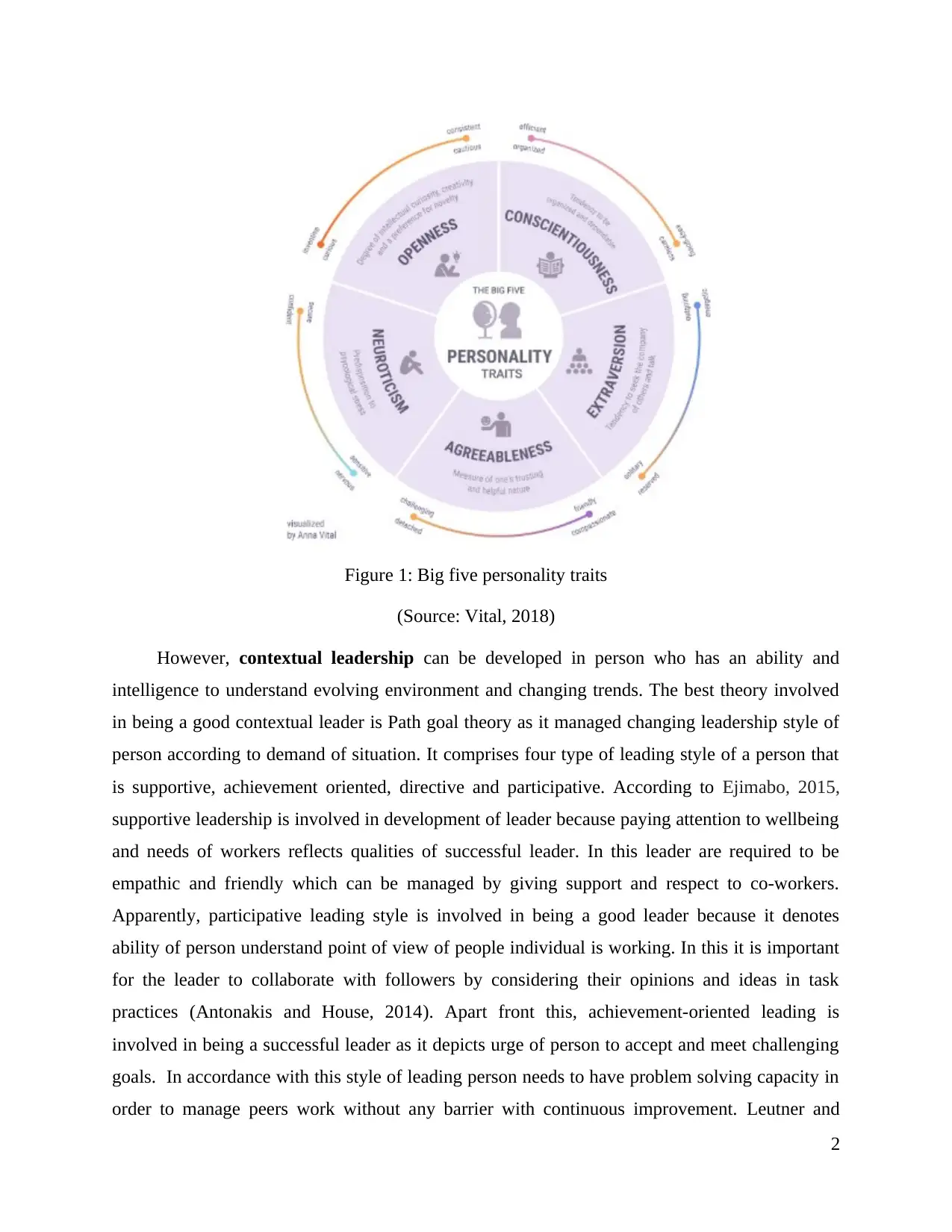
Figure 1: Big five personality traits
(Source: Vital, 2018)
However, contextual leadership can be developed in person who has an ability and
intelligence to understand evolving environment and changing trends. The best theory involved
in being a good contextual leader is Path goal theory as it managed changing leadership style of
person according to demand of situation. It comprises four type of leading style of a person that
is supportive, achievement oriented, directive and participative. According to Ejimabo, 2015,
supportive leadership is involved in development of leader because paying attention to wellbeing
and needs of workers reflects qualities of successful leader. In this leader are required to be
empathic and friendly which can be managed by giving support and respect to co-workers.
Apparently, participative leading style is involved in being a good leader because it denotes
ability of person understand point of view of people individual is working. In this it is important
for the leader to collaborate with followers by considering their opinions and ideas in task
practices (Antonakis and House, 2014). Apart front this, achievement-oriented leading is
involved in being a successful leader as it depicts urge of person to accept and meet challenging
goals. In accordance with this style of leading person needs to have problem solving capacity in
order to manage peers work without any barrier with continuous improvement. Leutner and
2
(Source: Vital, 2018)
However, contextual leadership can be developed in person who has an ability and
intelligence to understand evolving environment and changing trends. The best theory involved
in being a good contextual leader is Path goal theory as it managed changing leadership style of
person according to demand of situation. It comprises four type of leading style of a person that
is supportive, achievement oriented, directive and participative. According to Ejimabo, 2015,
supportive leadership is involved in development of leader because paying attention to wellbeing
and needs of workers reflects qualities of successful leader. In this leader are required to be
empathic and friendly which can be managed by giving support and respect to co-workers.
Apparently, participative leading style is involved in being a good leader because it denotes
ability of person understand point of view of people individual is working. In this it is important
for the leader to collaborate with followers by considering their opinions and ideas in task
practices (Antonakis and House, 2014). Apart front this, achievement-oriented leading is
involved in being a successful leader as it depicts urge of person to accept and meet challenging
goals. In accordance with this style of leading person needs to have problem solving capacity in
order to manage peers work without any barrier with continuous improvement. Leutner and
2
Paraphrase This Document
Need a fresh take? Get an instant paraphrase of this document with our AI Paraphraser
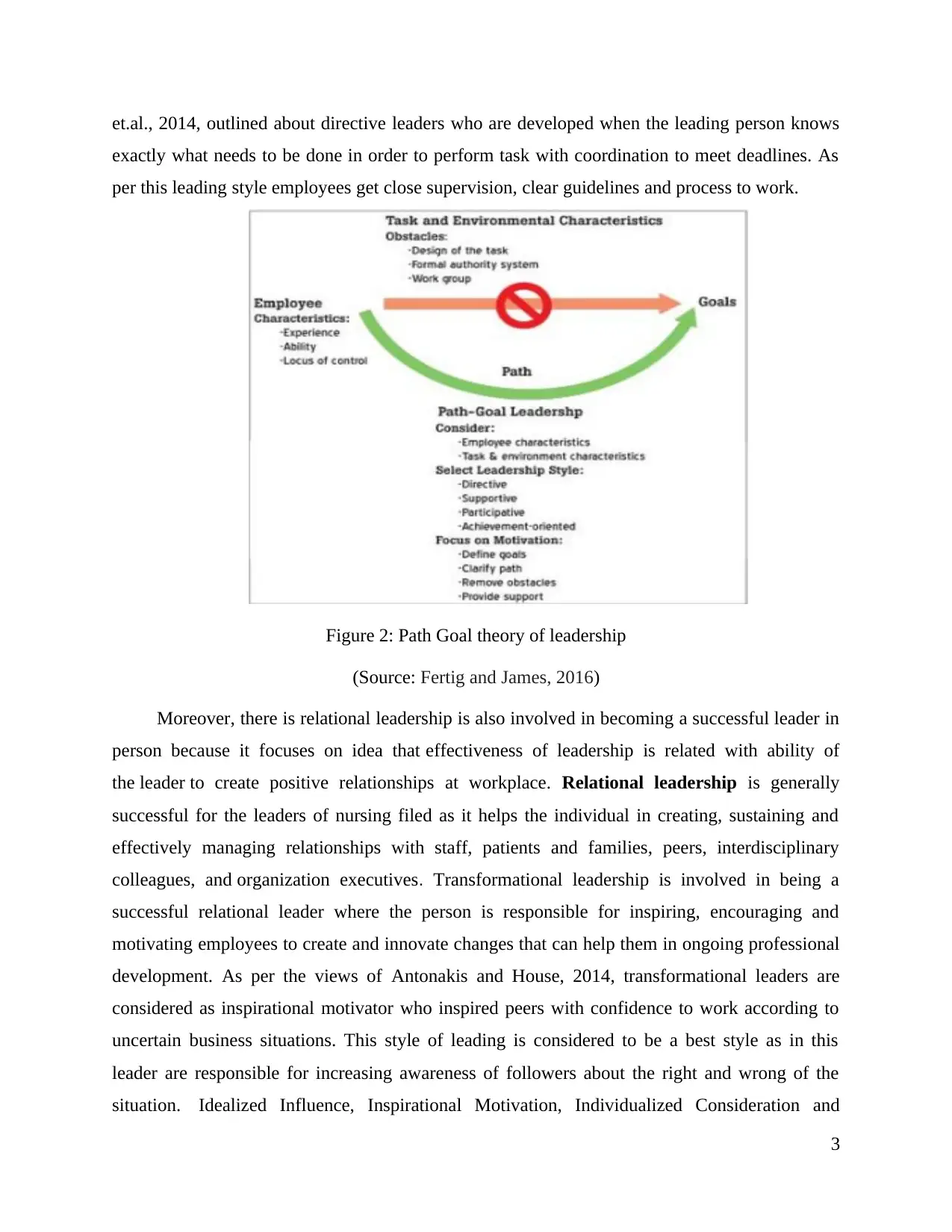
et.al., 2014, outlined about directive leaders who are developed when the leading person knows
exactly what needs to be done in order to perform task with coordination to meet deadlines. As
per this leading style employees get close supervision, clear guidelines and process to work.
Figure 2: Path Goal theory of leadership
(Source: Fertig and James, 2016)
Moreover, there is relational leadership is also involved in becoming a successful leader in
person because it focuses on idea that effectiveness of leadership is related with ability of
the leader to create positive relationships at workplace. Relational leadership is generally
successful for the leaders of nursing filed as it helps the individual in creating, sustaining and
effectively managing relationships with staff, patients and families, peers, interdisciplinary
colleagues, and organization executives. Transformational leadership is involved in being a
successful relational leader where the person is responsible for inspiring, encouraging and
motivating employees to create and innovate changes that can help them in ongoing professional
development. As per the views of Antonakis and House, 2014, transformational leaders are
considered as inspirational motivator who inspired peers with confidence to work according to
uncertain business situations. This style of leading is considered to be a best style as in this
leader are responsible for increasing awareness of followers about the right and wrong of the
situation. Idealized Influence, Inspirational Motivation, Individualized Consideration and
3
exactly what needs to be done in order to perform task with coordination to meet deadlines. As
per this leading style employees get close supervision, clear guidelines and process to work.
Figure 2: Path Goal theory of leadership
(Source: Fertig and James, 2016)
Moreover, there is relational leadership is also involved in becoming a successful leader in
person because it focuses on idea that effectiveness of leadership is related with ability of
the leader to create positive relationships at workplace. Relational leadership is generally
successful for the leaders of nursing filed as it helps the individual in creating, sustaining and
effectively managing relationships with staff, patients and families, peers, interdisciplinary
colleagues, and organization executives. Transformational leadership is involved in being a
successful relational leader where the person is responsible for inspiring, encouraging and
motivating employees to create and innovate changes that can help them in ongoing professional
development. As per the views of Antonakis and House, 2014, transformational leaders are
considered as inspirational motivator who inspired peers with confidence to work according to
uncertain business situations. This style of leading is considered to be a best style as in this
leader are responsible for increasing awareness of followers about the right and wrong of the
situation. Idealized Influence, Inspirational Motivation, Individualized Consideration and
3
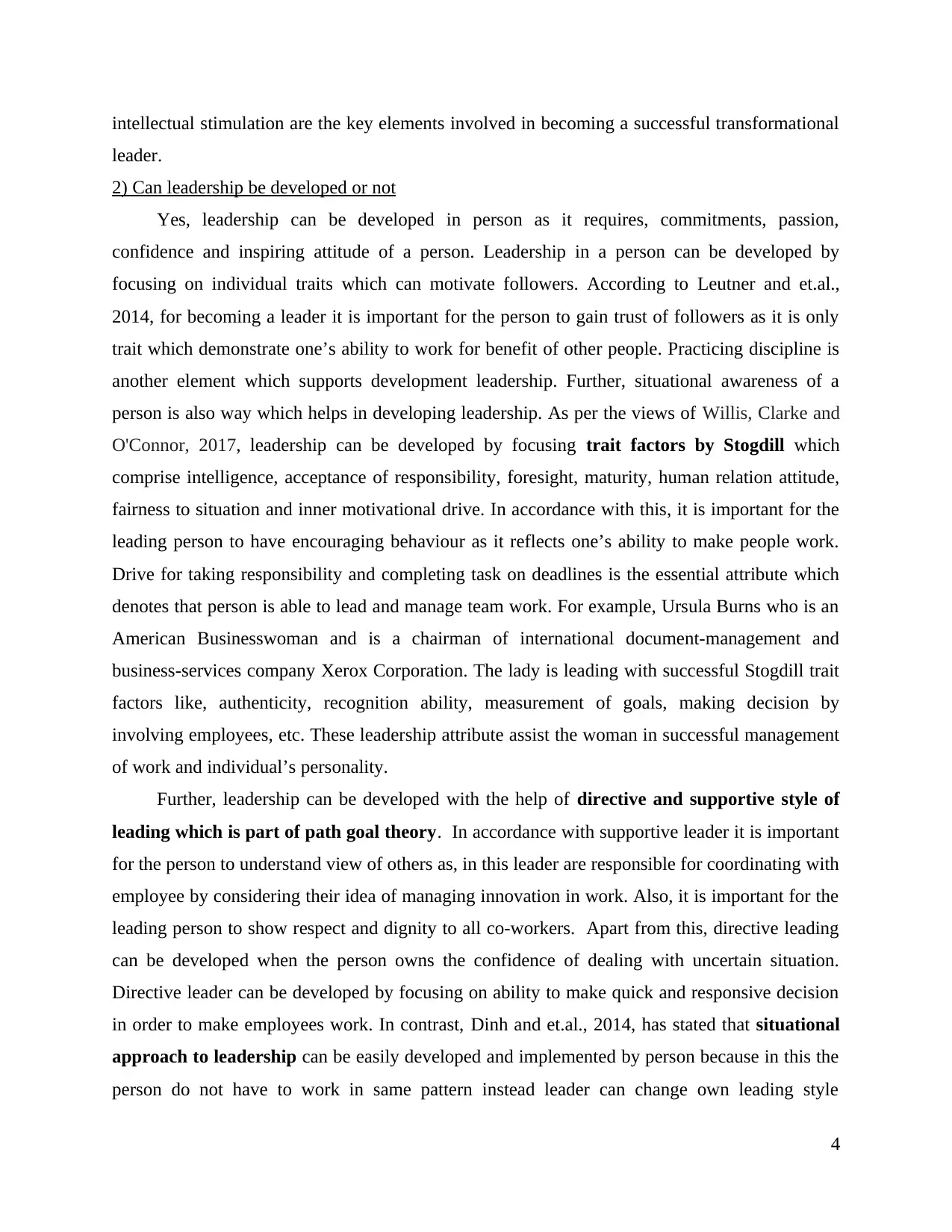
intellectual stimulation are the key elements involved in becoming a successful transformational
leader.
2) Can leadership be developed or not
Yes, leadership can be developed in person as it requires, commitments, passion,
confidence and inspiring attitude of a person. Leadership in a person can be developed by
focusing on individual traits which can motivate followers. According to Leutner and et.al.,
2014, for becoming a leader it is important for the person to gain trust of followers as it is only
trait which demonstrate one’s ability to work for benefit of other people. Practicing discipline is
another element which supports development leadership. Further, situational awareness of a
person is also way which helps in developing leadership. As per the views of Willis, Clarke and
O'Connor, 2017, leadership can be developed by focusing trait factors by Stogdill which
comprise intelligence, acceptance of responsibility, foresight, maturity, human relation attitude,
fairness to situation and inner motivational drive. In accordance with this, it is important for the
leading person to have encouraging behaviour as it reflects one’s ability to make people work.
Drive for taking responsibility and completing task on deadlines is the essential attribute which
denotes that person is able to lead and manage team work. For example, Ursula Burns who is an
American Businesswoman and is a chairman of international document-management and
business-services company Xerox Corporation. The lady is leading with successful Stogdill trait
factors like, authenticity, recognition ability, measurement of goals, making decision by
involving employees, etc. These leadership attribute assist the woman in successful management
of work and individual’s personality.
Further, leadership can be developed with the help of directive and supportive style of
leading which is part of path goal theory. In accordance with supportive leader it is important
for the person to understand view of others as, in this leader are responsible for coordinating with
employee by considering their idea of managing innovation in work. Also, it is important for the
leading person to show respect and dignity to all co-workers. Apart from this, directive leading
can be developed when the person owns the confidence of dealing with uncertain situation.
Directive leader can be developed by focusing on ability to make quick and responsive decision
in order to make employees work. In contrast, Dinh and et.al., 2014, has stated that situational
approach to leadership can be easily developed and implemented by person because in this the
person do not have to work in same pattern instead leader can change own leading style
4
leader.
2) Can leadership be developed or not
Yes, leadership can be developed in person as it requires, commitments, passion,
confidence and inspiring attitude of a person. Leadership in a person can be developed by
focusing on individual traits which can motivate followers. According to Leutner and et.al.,
2014, for becoming a leader it is important for the person to gain trust of followers as it is only
trait which demonstrate one’s ability to work for benefit of other people. Practicing discipline is
another element which supports development leadership. Further, situational awareness of a
person is also way which helps in developing leadership. As per the views of Willis, Clarke and
O'Connor, 2017, leadership can be developed by focusing trait factors by Stogdill which
comprise intelligence, acceptance of responsibility, foresight, maturity, human relation attitude,
fairness to situation and inner motivational drive. In accordance with this, it is important for the
leading person to have encouraging behaviour as it reflects one’s ability to make people work.
Drive for taking responsibility and completing task on deadlines is the essential attribute which
denotes that person is able to lead and manage team work. For example, Ursula Burns who is an
American Businesswoman and is a chairman of international document-management and
business-services company Xerox Corporation. The lady is leading with successful Stogdill trait
factors like, authenticity, recognition ability, measurement of goals, making decision by
involving employees, etc. These leadership attribute assist the woman in successful management
of work and individual’s personality.
Further, leadership can be developed with the help of directive and supportive style of
leading which is part of path goal theory. In accordance with supportive leader it is important
for the person to understand view of others as, in this leader are responsible for coordinating with
employee by considering their idea of managing innovation in work. Also, it is important for the
leading person to show respect and dignity to all co-workers. Apart from this, directive leading
can be developed when the person owns the confidence of dealing with uncertain situation.
Directive leader can be developed by focusing on ability to make quick and responsive decision
in order to make employees work. In contrast, Dinh and et.al., 2014, has stated that situational
approach to leadership can be easily developed and implemented by person because in this the
person do not have to work in same pattern instead leader can change own leading style
4
⊘ This is a preview!⊘
Do you want full access?
Subscribe today to unlock all pages.

Trusted by 1+ million students worldwide
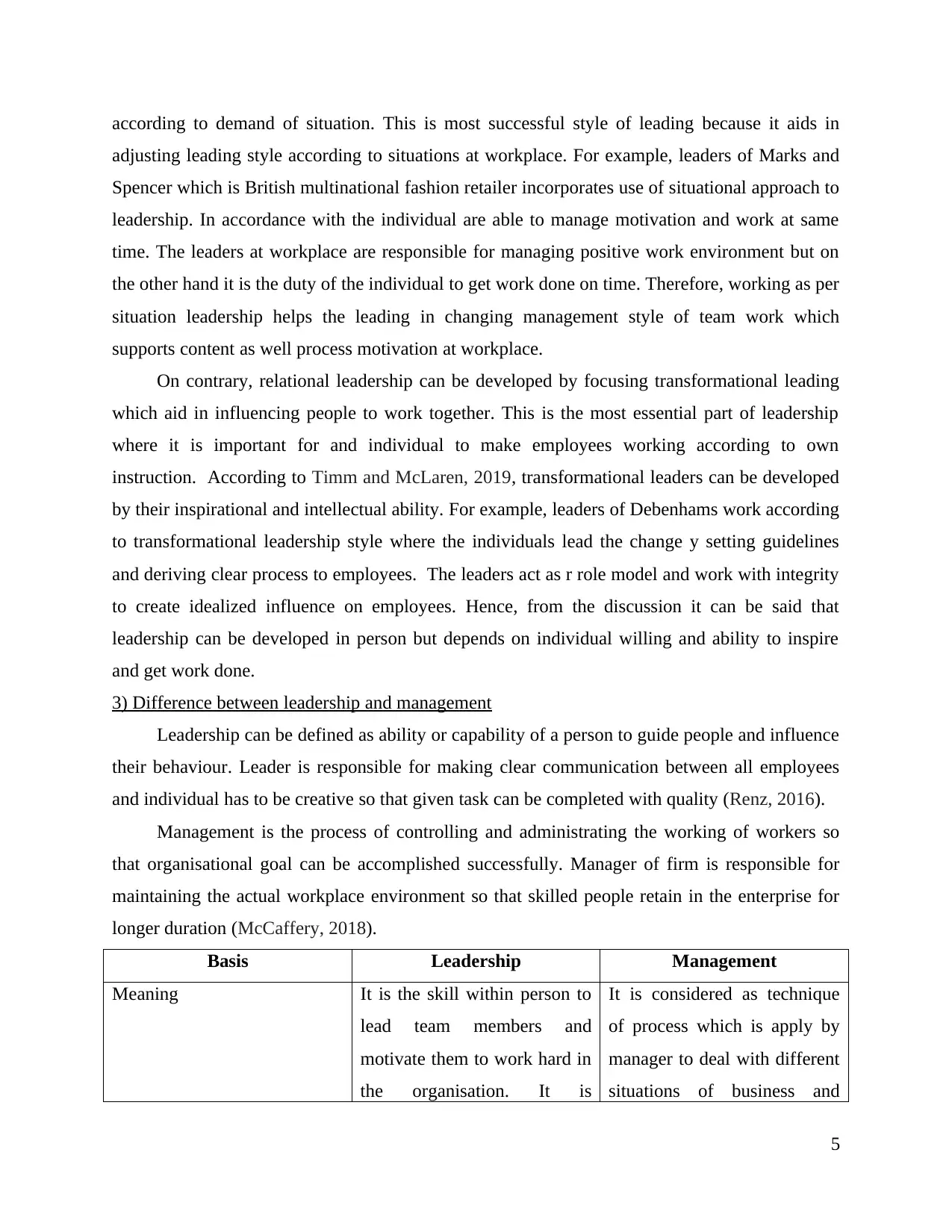
according to demand of situation. This is most successful style of leading because it aids in
adjusting leading style according to situations at workplace. For example, leaders of Marks and
Spencer which is British multinational fashion retailer incorporates use of situational approach to
leadership. In accordance with the individual are able to manage motivation and work at same
time. The leaders at workplace are responsible for managing positive work environment but on
the other hand it is the duty of the individual to get work done on time. Therefore, working as per
situation leadership helps the leading in changing management style of team work which
supports content as well process motivation at workplace.
On contrary, relational leadership can be developed by focusing transformational leading
which aid in influencing people to work together. This is the most essential part of leadership
where it is important for and individual to make employees working according to own
instruction. According to Timm and McLaren, 2019, transformational leaders can be developed
by their inspirational and intellectual ability. For example, leaders of Debenhams work according
to transformational leadership style where the individuals lead the change y setting guidelines
and deriving clear process to employees. The leaders act as r role model and work with integrity
to create idealized influence on employees. Hence, from the discussion it can be said that
leadership can be developed in person but depends on individual willing and ability to inspire
and get work done.
3) Difference between leadership and management
Leadership can be defined as ability or capability of a person to guide people and influence
their behaviour. Leader is responsible for making clear communication between all employees
and individual has to be creative so that given task can be completed with quality (Renz, 2016).
Management is the process of controlling and administrating the working of workers so
that organisational goal can be accomplished successfully. Manager of firm is responsible for
maintaining the actual workplace environment so that skilled people retain in the enterprise for
longer duration (McCaffery, 2018).
Basis Leadership Management
Meaning It is the skill within person to
lead team members and
motivate them to work hard in
the organisation. It is
It is considered as technique
of process which is apply by
manager to deal with different
situations of business and
5
adjusting leading style according to situations at workplace. For example, leaders of Marks and
Spencer which is British multinational fashion retailer incorporates use of situational approach to
leadership. In accordance with the individual are able to manage motivation and work at same
time. The leaders at workplace are responsible for managing positive work environment but on
the other hand it is the duty of the individual to get work done on time. Therefore, working as per
situation leadership helps the leading in changing management style of team work which
supports content as well process motivation at workplace.
On contrary, relational leadership can be developed by focusing transformational leading
which aid in influencing people to work together. This is the most essential part of leadership
where it is important for and individual to make employees working according to own
instruction. According to Timm and McLaren, 2019, transformational leaders can be developed
by their inspirational and intellectual ability. For example, leaders of Debenhams work according
to transformational leadership style where the individuals lead the change y setting guidelines
and deriving clear process to employees. The leaders act as r role model and work with integrity
to create idealized influence on employees. Hence, from the discussion it can be said that
leadership can be developed in person but depends on individual willing and ability to inspire
and get work done.
3) Difference between leadership and management
Leadership can be defined as ability or capability of a person to guide people and influence
their behaviour. Leader is responsible for making clear communication between all employees
and individual has to be creative so that given task can be completed with quality (Renz, 2016).
Management is the process of controlling and administrating the working of workers so
that organisational goal can be accomplished successfully. Manager of firm is responsible for
maintaining the actual workplace environment so that skilled people retain in the enterprise for
longer duration (McCaffery, 2018).
Basis Leadership Management
Meaning It is the skill within person to
lead team members and
motivate them to work hard in
the organisation. It is
It is considered as technique
of process which is apply by
manager to deal with different
situations of business and
5
Paraphrase This Document
Need a fresh take? Get an instant paraphrase of this document with our AI Paraphraser
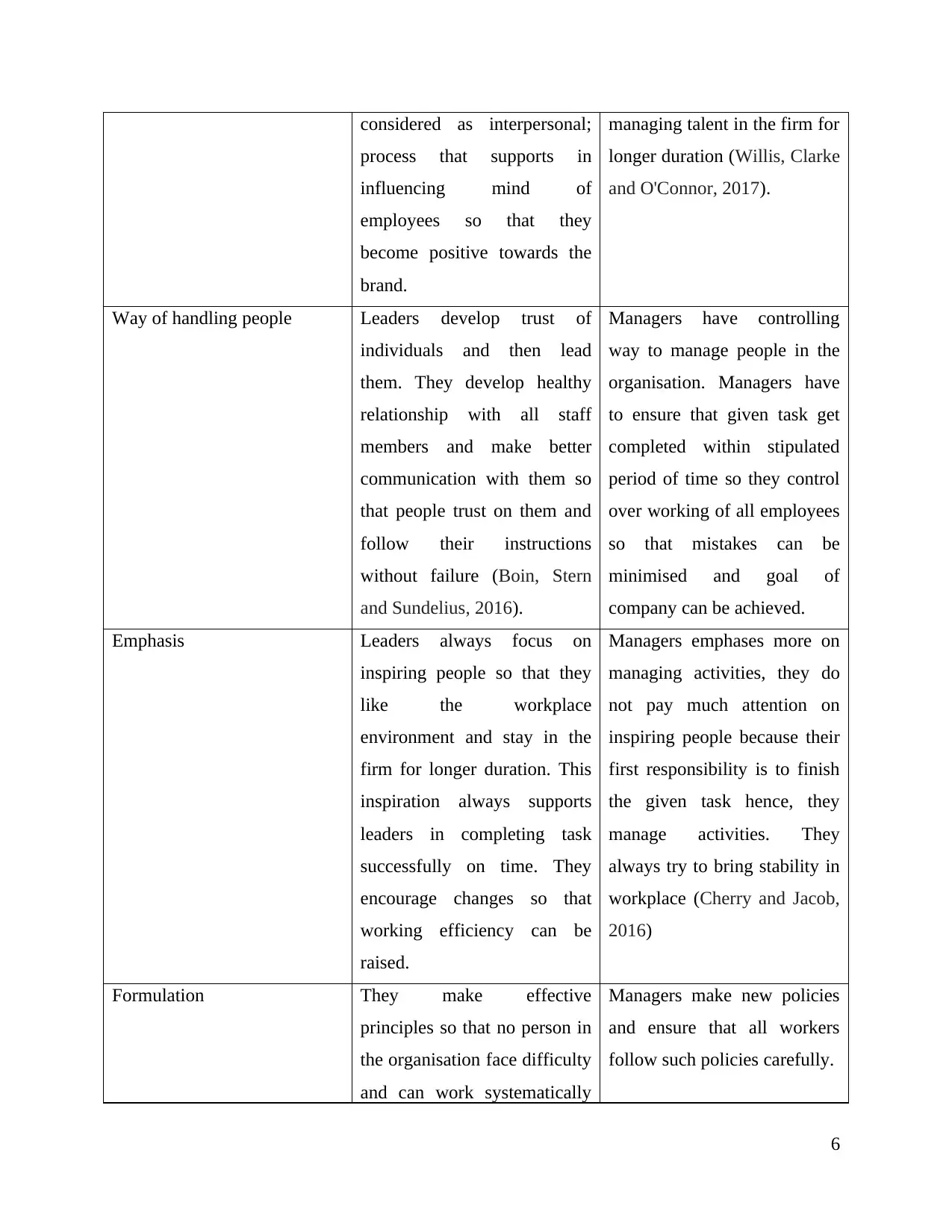
considered as interpersonal;
process that supports in
influencing mind of
employees so that they
become positive towards the
brand.
managing talent in the firm for
longer duration (Willis, Clarke
and O'Connor, 2017).
Way of handling people Leaders develop trust of
individuals and then lead
them. They develop healthy
relationship with all staff
members and make better
communication with them so
that people trust on them and
follow their instructions
without failure (Boin, Stern
and Sundelius, 2016).
Managers have controlling
way to manage people in the
organisation. Managers have
to ensure that given task get
completed within stipulated
period of time so they control
over working of all employees
so that mistakes can be
minimised and goal of
company can be achieved.
Emphasis Leaders always focus on
inspiring people so that they
like the workplace
environment and stay in the
firm for longer duration. This
inspiration always supports
leaders in completing task
successfully on time. They
encourage changes so that
working efficiency can be
raised.
Managers emphases more on
managing activities, they do
not pay much attention on
inspiring people because their
first responsibility is to finish
the given task hence, they
manage activities. They
always try to bring stability in
workplace (Cherry and Jacob,
2016)
Formulation They make effective
principles so that no person in
the organisation face difficulty
and can work systematically
Managers make new policies
and ensure that all workers
follow such policies carefully.
6
process that supports in
influencing mind of
employees so that they
become positive towards the
brand.
managing talent in the firm for
longer duration (Willis, Clarke
and O'Connor, 2017).
Way of handling people Leaders develop trust of
individuals and then lead
them. They develop healthy
relationship with all staff
members and make better
communication with them so
that people trust on them and
follow their instructions
without failure (Boin, Stern
and Sundelius, 2016).
Managers have controlling
way to manage people in the
organisation. Managers have
to ensure that given task get
completed within stipulated
period of time so they control
over working of all employees
so that mistakes can be
minimised and goal of
company can be achieved.
Emphasis Leaders always focus on
inspiring people so that they
like the workplace
environment and stay in the
firm for longer duration. This
inspiration always supports
leaders in completing task
successfully on time. They
encourage changes so that
working efficiency can be
raised.
Managers emphases more on
managing activities, they do
not pay much attention on
inspiring people because their
first responsibility is to finish
the given task hence, they
manage activities. They
always try to bring stability in
workplace (Cherry and Jacob,
2016)
Formulation They make effective
principles so that no person in
the organisation face difficulty
and can work systematically
Managers make new policies
and ensure that all workers
follow such policies carefully.
6
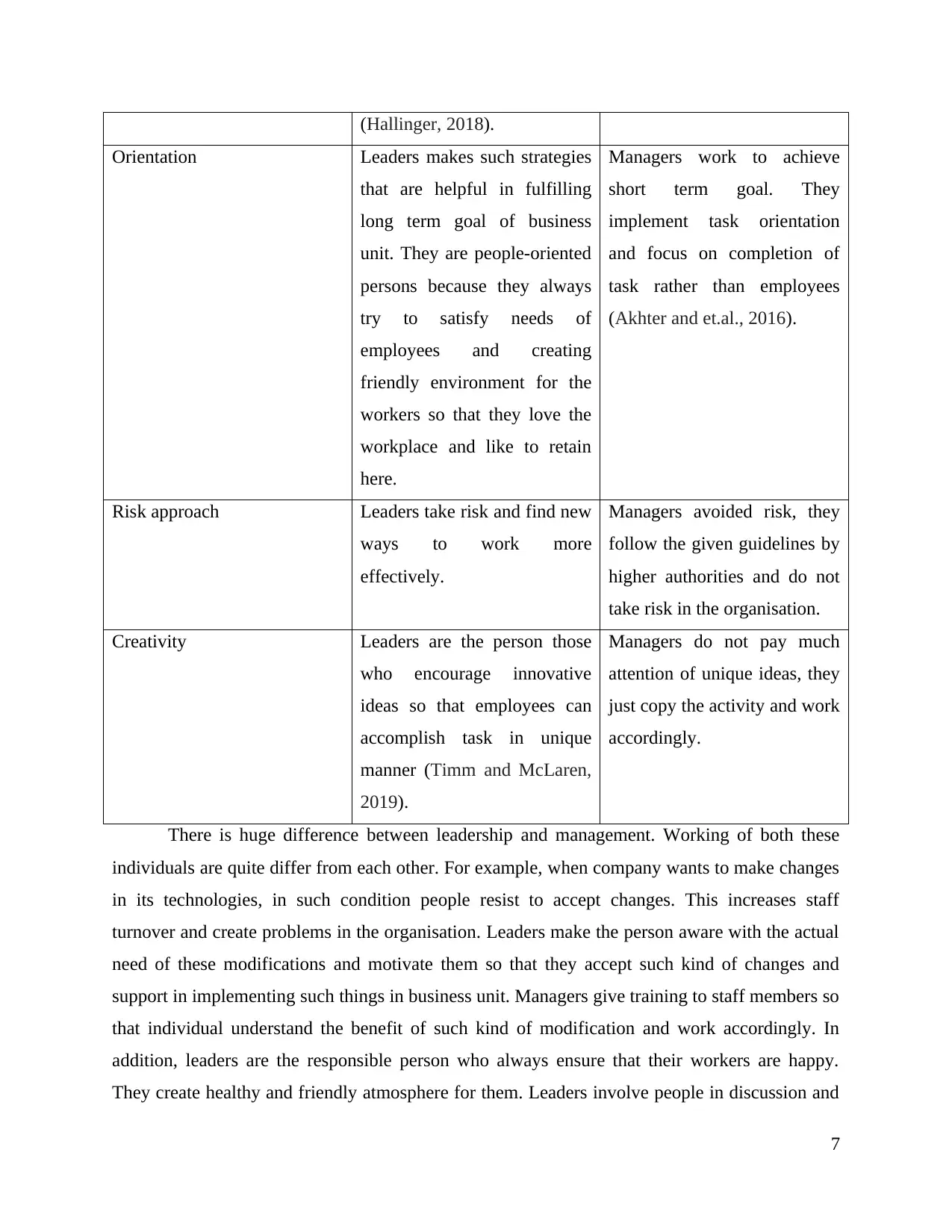
(Hallinger, 2018).
Orientation Leaders makes such strategies
that are helpful in fulfilling
long term goal of business
unit. They are people-oriented
persons because they always
try to satisfy needs of
employees and creating
friendly environment for the
workers so that they love the
workplace and like to retain
here.
Managers work to achieve
short term goal. They
implement task orientation
and focus on completion of
task rather than employees
(Akhter and et.al., 2016).
Risk approach Leaders take risk and find new
ways to work more
effectively.
Managers avoided risk, they
follow the given guidelines by
higher authorities and do not
take risk in the organisation.
Creativity Leaders are the person those
who encourage innovative
ideas so that employees can
accomplish task in unique
manner (Timm and McLaren,
2019).
Managers do not pay much
attention of unique ideas, they
just copy the activity and work
accordingly.
There is huge difference between leadership and management. Working of both these
individuals are quite differ from each other. For example, when company wants to make changes
in its technologies, in such condition people resist to accept changes. This increases staff
turnover and create problems in the organisation. Leaders make the person aware with the actual
need of these modifications and motivate them so that they accept such kind of changes and
support in implementing such things in business unit. Managers give training to staff members so
that individual understand the benefit of such kind of modification and work accordingly. In
addition, leaders are the responsible person who always ensure that their workers are happy.
They create healthy and friendly atmosphere for them. Leaders involve people in discussion and
7
Orientation Leaders makes such strategies
that are helpful in fulfilling
long term goal of business
unit. They are people-oriented
persons because they always
try to satisfy needs of
employees and creating
friendly environment for the
workers so that they love the
workplace and like to retain
here.
Managers work to achieve
short term goal. They
implement task orientation
and focus on completion of
task rather than employees
(Akhter and et.al., 2016).
Risk approach Leaders take risk and find new
ways to work more
effectively.
Managers avoided risk, they
follow the given guidelines by
higher authorities and do not
take risk in the organisation.
Creativity Leaders are the person those
who encourage innovative
ideas so that employees can
accomplish task in unique
manner (Timm and McLaren,
2019).
Managers do not pay much
attention of unique ideas, they
just copy the activity and work
accordingly.
There is huge difference between leadership and management. Working of both these
individuals are quite differ from each other. For example, when company wants to make changes
in its technologies, in such condition people resist to accept changes. This increases staff
turnover and create problems in the organisation. Leaders make the person aware with the actual
need of these modifications and motivate them so that they accept such kind of changes and
support in implementing such things in business unit. Managers give training to staff members so
that individual understand the benefit of such kind of modification and work accordingly. In
addition, leaders are the responsible person who always ensure that their workers are happy.
They create healthy and friendly atmosphere for them. Leaders involve people in discussion and
7
⊘ This is a preview!⊘
Do you want full access?
Subscribe today to unlock all pages.

Trusted by 1+ million students worldwide
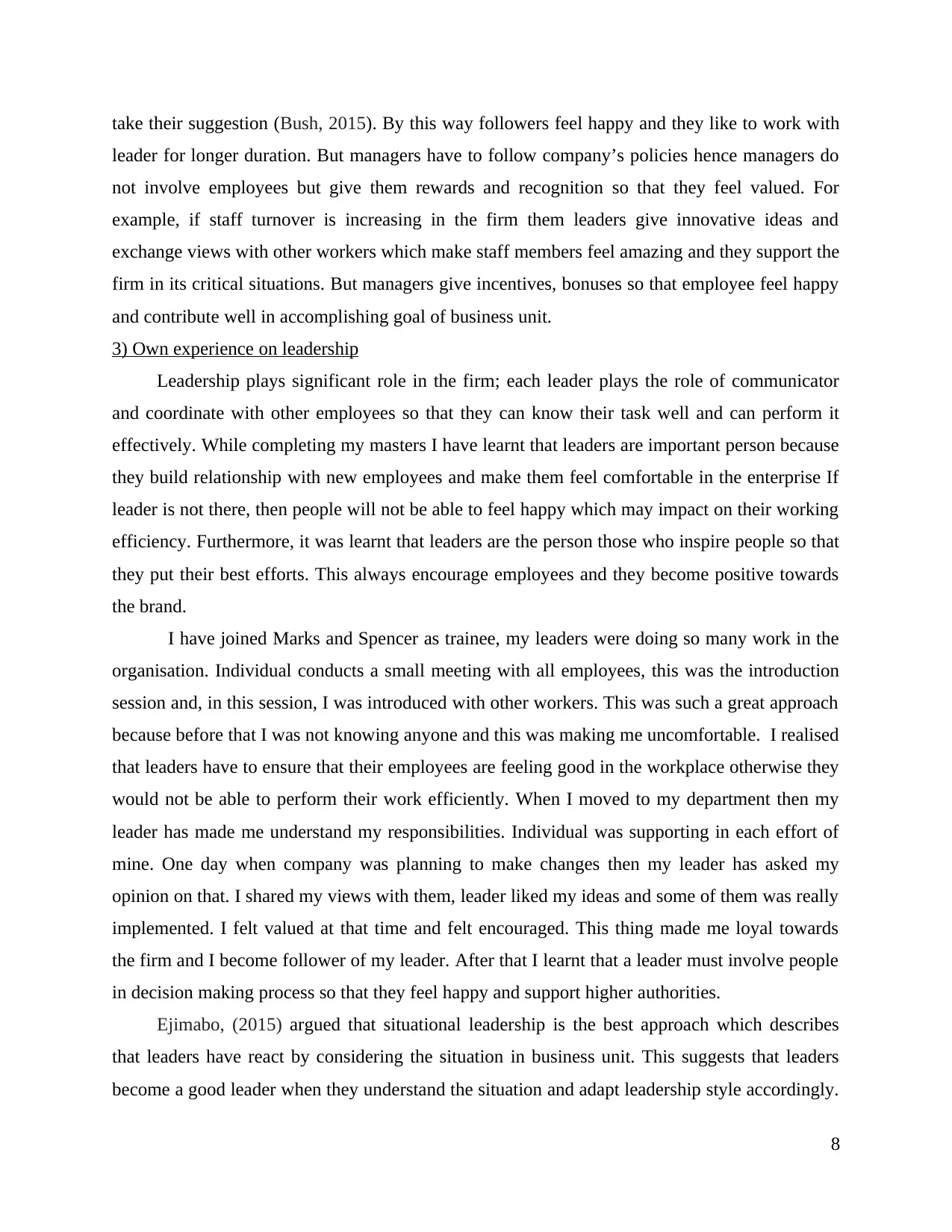
take their suggestion (Bush, 2015). By this way followers feel happy and they like to work with
leader for longer duration. But managers have to follow company’s policies hence managers do
not involve employees but give them rewards and recognition so that they feel valued. For
example, if staff turnover is increasing in the firm them leaders give innovative ideas and
exchange views with other workers which make staff members feel amazing and they support the
firm in its critical situations. But managers give incentives, bonuses so that employee feel happy
and contribute well in accomplishing goal of business unit.
3) Own experience on leadership
Leadership plays significant role in the firm; each leader plays the role of communicator
and coordinate with other employees so that they can know their task well and can perform it
effectively. While completing my masters I have learnt that leaders are important person because
they build relationship with new employees and make them feel comfortable in the enterprise If
leader is not there, then people will not be able to feel happy which may impact on their working
efficiency. Furthermore, it was learnt that leaders are the person those who inspire people so that
they put their best efforts. This always encourage employees and they become positive towards
the brand.
I have joined Marks and Spencer as trainee, my leaders were doing so many work in the
organisation. Individual conducts a small meeting with all employees, this was the introduction
session and, in this session, I was introduced with other workers. This was such a great approach
because before that I was not knowing anyone and this was making me uncomfortable. I realised
that leaders have to ensure that their employees are feeling good in the workplace otherwise they
would not be able to perform their work efficiently. When I moved to my department then my
leader has made me understand my responsibilities. Individual was supporting in each effort of
mine. One day when company was planning to make changes then my leader has asked my
opinion on that. I shared my views with them, leader liked my ideas and some of them was really
implemented. I felt valued at that time and felt encouraged. This thing made me loyal towards
the firm and I become follower of my leader. After that I learnt that a leader must involve people
in decision making process so that they feel happy and support higher authorities.
Ejimabo, (2015) argued that situational leadership is the best approach which describes
that leaders have react by considering the situation in business unit. This suggests that leaders
become a good leader when they understand the situation and adapt leadership style accordingly.
8
leader for longer duration. But managers have to follow company’s policies hence managers do
not involve employees but give them rewards and recognition so that they feel valued. For
example, if staff turnover is increasing in the firm them leaders give innovative ideas and
exchange views with other workers which make staff members feel amazing and they support the
firm in its critical situations. But managers give incentives, bonuses so that employee feel happy
and contribute well in accomplishing goal of business unit.
3) Own experience on leadership
Leadership plays significant role in the firm; each leader plays the role of communicator
and coordinate with other employees so that they can know their task well and can perform it
effectively. While completing my masters I have learnt that leaders are important person because
they build relationship with new employees and make them feel comfortable in the enterprise If
leader is not there, then people will not be able to feel happy which may impact on their working
efficiency. Furthermore, it was learnt that leaders are the person those who inspire people so that
they put their best efforts. This always encourage employees and they become positive towards
the brand.
I have joined Marks and Spencer as trainee, my leaders were doing so many work in the
organisation. Individual conducts a small meeting with all employees, this was the introduction
session and, in this session, I was introduced with other workers. This was such a great approach
because before that I was not knowing anyone and this was making me uncomfortable. I realised
that leaders have to ensure that their employees are feeling good in the workplace otherwise they
would not be able to perform their work efficiently. When I moved to my department then my
leader has made me understand my responsibilities. Individual was supporting in each effort of
mine. One day when company was planning to make changes then my leader has asked my
opinion on that. I shared my views with them, leader liked my ideas and some of them was really
implemented. I felt valued at that time and felt encouraged. This thing made me loyal towards
the firm and I become follower of my leader. After that I learnt that a leader must involve people
in decision making process so that they feel happy and support higher authorities.
Ejimabo, (2015) argued that situational leadership is the best approach which describes
that leaders have react by considering the situation in business unit. This suggests that leaders
become a good leader when they understand the situation and adapt leadership style accordingly.
8
Paraphrase This Document
Need a fresh take? Get an instant paraphrase of this document with our AI Paraphraser
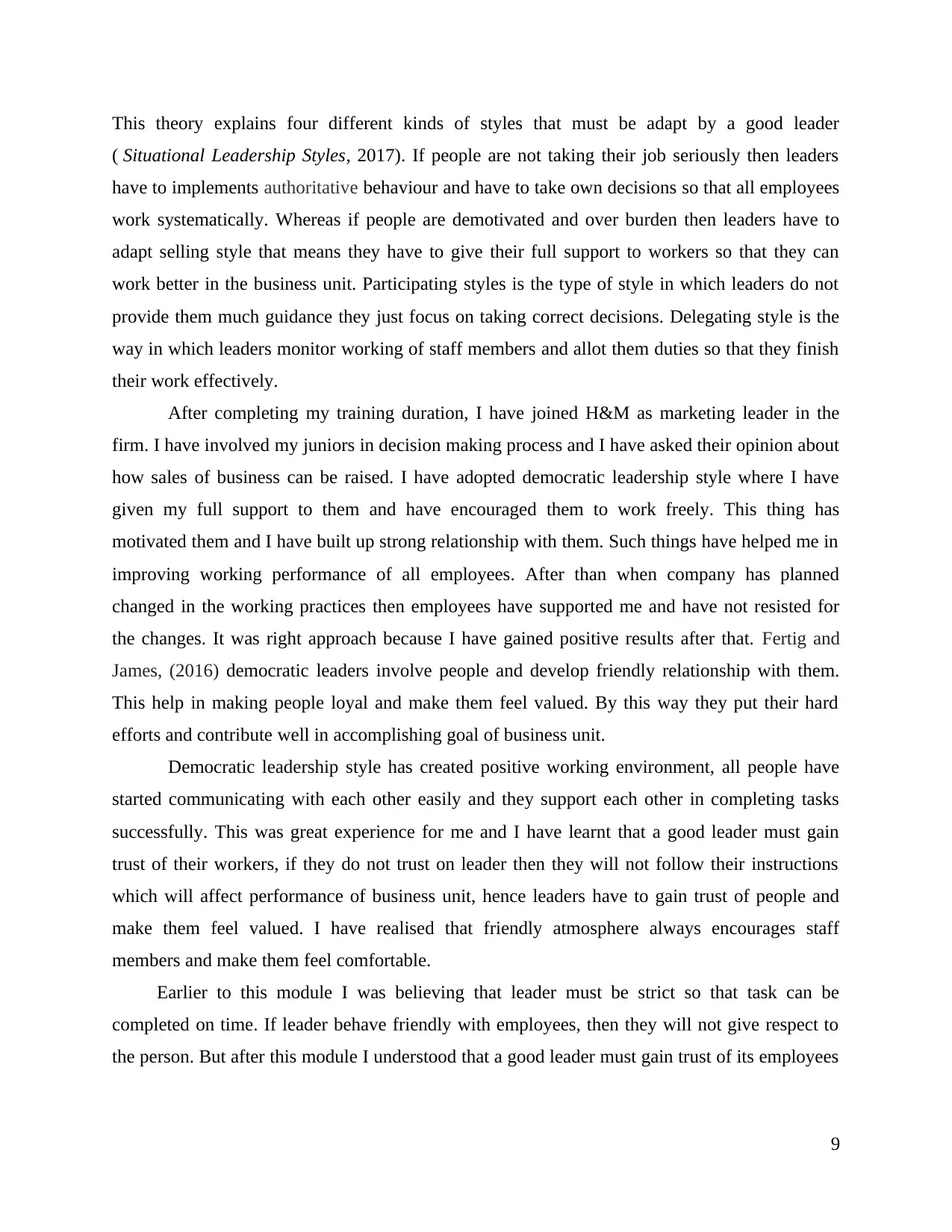
This theory explains four different kinds of styles that must be adapt by a good leader
( Situational Leadership Styles, 2017). If people are not taking their job seriously then leaders
have to implements authoritative behaviour and have to take own decisions so that all employees
work systematically. Whereas if people are demotivated and over burden then leaders have to
adapt selling style that means they have to give their full support to workers so that they can
work better in the business unit. Participating styles is the type of style in which leaders do not
provide them much guidance they just focus on taking correct decisions. Delegating style is the
way in which leaders monitor working of staff members and allot them duties so that they finish
their work effectively.
After completing my training duration, I have joined H&M as marketing leader in the
firm. I have involved my juniors in decision making process and I have asked their opinion about
how sales of business can be raised. I have adopted democratic leadership style where I have
given my full support to them and have encouraged them to work freely. This thing has
motivated them and I have built up strong relationship with them. Such things have helped me in
improving working performance of all employees. After than when company has planned
changed in the working practices then employees have supported me and have not resisted for
the changes. It was right approach because I have gained positive results after that. Fertig and
James, (2016) democratic leaders involve people and develop friendly relationship with them.
This help in making people loyal and make them feel valued. By this way they put their hard
efforts and contribute well in accomplishing goal of business unit.
Democratic leadership style has created positive working environment, all people have
started communicating with each other easily and they support each other in completing tasks
successfully. This was great experience for me and I have learnt that a good leader must gain
trust of their workers, if they do not trust on leader then they will not follow their instructions
which will affect performance of business unit, hence leaders have to gain trust of people and
make them feel valued. I have realised that friendly atmosphere always encourages staff
members and make them feel comfortable.
Earlier to this module I was believing that leader must be strict so that task can be
completed on time. If leader behave friendly with employees, then they will not give respect to
the person. But after this module I understood that a good leader must gain trust of its employees
9
( Situational Leadership Styles, 2017). If people are not taking their job seriously then leaders
have to implements authoritative behaviour and have to take own decisions so that all employees
work systematically. Whereas if people are demotivated and over burden then leaders have to
adapt selling style that means they have to give their full support to workers so that they can
work better in the business unit. Participating styles is the type of style in which leaders do not
provide them much guidance they just focus on taking correct decisions. Delegating style is the
way in which leaders monitor working of staff members and allot them duties so that they finish
their work effectively.
After completing my training duration, I have joined H&M as marketing leader in the
firm. I have involved my juniors in decision making process and I have asked their opinion about
how sales of business can be raised. I have adopted democratic leadership style where I have
given my full support to them and have encouraged them to work freely. This thing has
motivated them and I have built up strong relationship with them. Such things have helped me in
improving working performance of all employees. After than when company has planned
changed in the working practices then employees have supported me and have not resisted for
the changes. It was right approach because I have gained positive results after that. Fertig and
James, (2016) democratic leaders involve people and develop friendly relationship with them.
This help in making people loyal and make them feel valued. By this way they put their hard
efforts and contribute well in accomplishing goal of business unit.
Democratic leadership style has created positive working environment, all people have
started communicating with each other easily and they support each other in completing tasks
successfully. This was great experience for me and I have learnt that a good leader must gain
trust of their workers, if they do not trust on leader then they will not follow their instructions
which will affect performance of business unit, hence leaders have to gain trust of people and
make them feel valued. I have realised that friendly atmosphere always encourages staff
members and make them feel comfortable.
Earlier to this module I was believing that leader must be strict so that task can be
completed on time. If leader behave friendly with employees, then they will not give respect to
the person. But after this module I understood that a good leader must gain trust of its employees
9

and involve them in each decision. This develops loyalty and they follow the instruction of
leader. This helps in completing the task on time and with great quality.
10
leader. This helps in completing the task on time and with great quality.
10
⊘ This is a preview!⊘
Do you want full access?
Subscribe today to unlock all pages.

Trusted by 1+ million students worldwide
1 out of 13
Related Documents
Your All-in-One AI-Powered Toolkit for Academic Success.
+13062052269
info@desklib.com
Available 24*7 on WhatsApp / Email
![[object Object]](/_next/static/media/star-bottom.7253800d.svg)
Unlock your academic potential
Copyright © 2020–2025 A2Z Services. All Rights Reserved. Developed and managed by ZUCOL.




